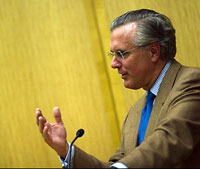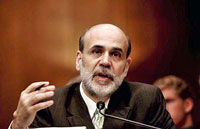What Dissension in the Fed's Ranks Means
Interest-Rates / US Interest Rates Feb 11, 2011 - 09:14 AM GMTBy: Mike_Larson
 A remarkable thing happened this week. Truly remarkable. But just in case it got lost amid the Egyptian chaos … coverage of the subzero temperatures up north … or the after-analysis of the Super Bowl, I’m going to shout it from the rooftops for you:
A remarkable thing happened this week. Truly remarkable. But just in case it got lost amid the Egyptian chaos … coverage of the subzero temperatures up north … or the after-analysis of the Super Bowl, I’m going to shout it from the rooftops for you:
A couple of Federal Reserve officials actually stood up and said “Enough is enough!”
Hard to believe, I know. But both Richmond Federal Reserve Bank President Jeffrey Lacker and Dallas Fed President Richard Fisher essentially said this week that the days of “QE Forever!” are over.
Markets are moving in response, so it’s imperative that you understand what they said — and what it means for your investing strategy.
Is Tighter Money Coming? Lacker and Fisher Are Leaning That Way!
Lacker spoke at the University of Delaware on Tuesday. He talked quite a bit about the economy and inflation — the usual stuff you get in any Fed speech. But he also delivered the following, notable assessment of QE2:
“The Committee recognized that the provision of further monetary stimulus at this point in the business cycle is not without risks, and therefore committed to regularly review the pace and overall size of the asset-purchase program in light of incoming information and adjust the program as needed.
“The distinct improvement in the economic outlook since the program was initiated suggests taking that re-evaluation quite seriously. That re-evaluation will be challenging, because inflation is capable of accelerating, even if the level of economic activity has not yet returned to pre-recession trend.”
Fedspeak can be hard to decipher if you haven’t been doing it for a long time like I have. So let me translate Lacker’s comments into English.
He essentially said: “QE2 was a Hail Mary pass to boost the economy — one that looks pretty stupid and unnecessary now, given the fact the latest data shows a recovery underway. So it’s time to pull the plug!”
|
Then there’s Fisher, one of my favorite policymakers at the Fed. He’s colorful with his comments, generally on target with his analysis, and actually willing to lean against the consensus if necessary. He gave a speech on Tuesday before the Stemmons Corridor Business Association in Dallas, and had the following to say …
“Barring some unexpected shock to the economy or financial system, I think we are pushing the envelope with the current round of Treasury purchases. I would be very wary of expanding our balance sheet further; indeed, given current economic and financial conditions, it is hard for me to envision a scenario where I would not use my voting position this year to formally dissent should the FOMC recommend another tranche of monetary accommodation.
“And I expect I will be at the forefront of the effort to trim back our Treasury holdings and tighten policy at the earliest sign that inflationary pressures are moving beyond the commodity markets and into the general price stream.”
Unlike Lockhart’s comments, these need no translation. Fisher is clearly not content to just sit idly by while the latest flood of Fed funny money drives prices inexorably higher.
Fed “Doves” Still Have the Upper Hand … but the Market Is Sniffing Out a Change!
I wish I could say that Lacker’s and Fisher’s views were dominant at the Fed. But unfortunately, that doesn’t appear to be the case.
The very same day they gave their speeches, Atlanta Fed President Dennis Lockhart spoke in Alabama. After going on and on about how prices are rising for things like food and energy, and how mainstream America can feel and see inflation every day, he reiterated the Fed’s mantra that such things don’t matter because their pet “core” inflation measures aren’t rising. His actual words?
“For the moment, inflation, properly defined, is tame, in my view. And the rise of individual prices does not signal incipient inflation.”
Then there’s Ben Bernanke himself. In front of the House Budget Committee on Wednesday, he said that “overall inflation is still quite low and longer-term inflation expectations have remained stable.” He also defended the latest bout of QE.
|
But you know what? The market isn’t listening to the interest rate “doves” like Lockhart and Bernanke. It’s siding with the “hawks” — Lacker and Fisher.
Remember that Eurodollar futures chart I showed you a couple weeks ago? The one that showed how these investments, which track expectations about future short-term interest rates, are tanking … signaling that investors are betting real money on higher rates down the road?
Well, they keep on falling like a rock. Doesn’t matter what month or what year contract you’re talking about. Virtually every single one is losing value. That’s just further confirmation that the Fed is going to be forced to shift to a tighter stance, whether Bernanke wants to do it or not!
So What Can You Do about All of This?
Well, I’d continue to stay away from longer-term bonds, as I’ve been counseling for some time. Rising rates are bad news for holders of fixed-income securities. You want to buy bonds near the END of a rate hiking cycle, not the beginning!
We may also soon see a reversal of a recent trend. For many months, long-term rates have been rising faster than short-term rates. That means the difference between the two kinds of rates has widened significantly — or in industry jargon, the “yield curve has steepened.”
If the Fed does start raising short-term rates, all rates will likely go up … but short-term rates could start rising more quickly. That would flatten the yield curve, and make an ETN like the iPath US Treasury Flattener Exchange Traded Note (FLAT) an interesting play.
This ETN seeks to replicate the inverse performance of the Barclays Capital U.S. Treasury 2Y/10Y Yield Curve Index. The index is designed to increase when the yield curve steepens and decrease when it flattens. So as short-term rates get closer to long-term rates, FLAT should rise in value.
It would also take the wind out of the sails of the core banking sector, because a flatter yield curve would put pressure on profit margins there.
Bottom line: Changes are afoot in the interest rate market. They could have serious implications for your wealth. So keep paying attention to this column each Friday for more guidance and analysis.
Until next time,
Mike
This investment news is brought to you by Money and Markets. Money and Markets is a free daily investment newsletter from Martin D. Weiss and Weiss Research analysts offering the latest investing news and financial insights for the stock market, including tips and advice on investing in gold, energy and oil. Dr. Weiss is a leader in the fields of investing, interest rates, financial safety and economic forecasting. To view archives or subscribe, visit http://www.moneyandmarkets.com.
© 2005-2022 http://www.MarketOracle.co.uk - The Market Oracle is a FREE Daily Financial Markets Analysis & Forecasting online publication.





